How do storage tanks safeguard the safe storage of industrial fluids through structural strength and reliable sealing?
Release Time : 2025-11-18
In numerous industrial sectors such as chemical, food, pharmaceutical, energy, and environmental protection, storage tanks, as core containers for storing liquid, gas, or powder media, directly impact production safety, material purity, and environmental compliance. A seemingly simple steel storage tank actually embodies the combined wisdom of materials science, welding processes, sealing technology, and pressure vessel design. The tank body, precision-welded from high-strength steel plates, coupled with a robust and reliable lid system, not only withstands the static pressure and dynamic loads of several tons or even hundreds of tons of media, but also constructs a silent yet indestructible safety barrier through daily operation.
The core advantages of storage tanks are primarily reflected in their structural integrity and pressure-bearing capacity. The tank body typically uses specialized pressure vessel steel plates such as Q345R, SUS304, or 316L. The thickness is precisely calculated based on the volume, media density, and operating pressure. After CNC plasma cutting, certified welders complete the circumferential and longitudinal seam welding using submerged arc welding or TIG welding processes. 100% of welds undergo ultrasonic (UT) or radiographic (RT) flaw detection to ensure the absence of cracks, porosity, or lack of fusion defects. The entire structure undergoes stress-relief heat treatment (PWHT) to significantly reduce residual stress and improve fatigue and brittle fracture resistance. The large vertical storage tank is also equipped with reinforcing rings, wind-resistant rings, and a ground anchoring system, capable of withstanding earthquakes of magnitude 8 and typhoons of category 12.
Sealing performance is crucial for ensuring media purity and environmental safety. The tank lid uses a flange connection or quick-release clamp structure, with food-grade silicone, PTFE-coated gaskets, or spiral wound gaskets to achieve a static seal with zero leakage. For volatile or toxic media, the tank top also integrates a breather valve, flame arrestor, and nitrogen sealing device to maintain a slight positive pressure inside the tank while preventing air backflow or vapor escape. The inner wall is polished (Ra≤0.4μm), acid-washed and passivated, or sprayed with epoxy phenolic resin according to the media characteristics to eliminate corrosion and cross-contamination, meeting stringent standards such as GMP, FDA, and ASME BPE.
Functional expandability further enhances application value. Modern storage tanks can integrate level gauges, temperature sensors, CIP/SIP cleaning interfaces, stirring devices, and sampling valves, enabling intelligent monitoring and automated operation. The double-walled structure with a leak detection interlayer is suitable for storing hazardous chemicals. The combination of insulation (rock wool or polyurethane) and heating tape ensures normal flow of high-viscosity media in low-temperature environments. From 500-liter laboratory buffer tanks to 2000-cubic-meter large raw material tanks, modular design supports customization to suit different process flows.
Lifecycle reliability stems from stringent quality control. From incoming material inspection, welding procedure qualification (WPS/PQR), hydrostatic testing (holding pressure at 1.25 times design pressure for 30 minutes without leakage) to final sandblasting and coating, every process complies with GB 150 "Pressure Vessels," API 650, or EN 13445 international standards. Helium mass spectrometry leak testing or soap bubble testing is performed before shipment to ensure a sealing rating of ISO 228-1 Class A standard.
Ultimately, the value of a storage tank lies not only in "containing substances," but also in its silent, steel structure that safeguards a drop of purity amidst the roar of chemical plants and maintains safety in the pristine environment of food processing plants. Whether a tank of high-purity reagent is stably ready for use or tons of edible oil are safely stored, this industrial container is silently fulfilling its mission. In today's world, where safe production and green manufacturing are increasingly important, high-performance storage tanks, with their triple guarantees of strength, sealing, and intelligence, continue to solidify the foundation of modern industrial fluid storage.
The core advantages of storage tanks are primarily reflected in their structural integrity and pressure-bearing capacity. The tank body typically uses specialized pressure vessel steel plates such as Q345R, SUS304, or 316L. The thickness is precisely calculated based on the volume, media density, and operating pressure. After CNC plasma cutting, certified welders complete the circumferential and longitudinal seam welding using submerged arc welding or TIG welding processes. 100% of welds undergo ultrasonic (UT) or radiographic (RT) flaw detection to ensure the absence of cracks, porosity, or lack of fusion defects. The entire structure undergoes stress-relief heat treatment (PWHT) to significantly reduce residual stress and improve fatigue and brittle fracture resistance. The large vertical storage tank is also equipped with reinforcing rings, wind-resistant rings, and a ground anchoring system, capable of withstanding earthquakes of magnitude 8 and typhoons of category 12.
Sealing performance is crucial for ensuring media purity and environmental safety. The tank lid uses a flange connection or quick-release clamp structure, with food-grade silicone, PTFE-coated gaskets, or spiral wound gaskets to achieve a static seal with zero leakage. For volatile or toxic media, the tank top also integrates a breather valve, flame arrestor, and nitrogen sealing device to maintain a slight positive pressure inside the tank while preventing air backflow or vapor escape. The inner wall is polished (Ra≤0.4μm), acid-washed and passivated, or sprayed with epoxy phenolic resin according to the media characteristics to eliminate corrosion and cross-contamination, meeting stringent standards such as GMP, FDA, and ASME BPE.
Functional expandability further enhances application value. Modern storage tanks can integrate level gauges, temperature sensors, CIP/SIP cleaning interfaces, stirring devices, and sampling valves, enabling intelligent monitoring and automated operation. The double-walled structure with a leak detection interlayer is suitable for storing hazardous chemicals. The combination of insulation (rock wool or polyurethane) and heating tape ensures normal flow of high-viscosity media in low-temperature environments. From 500-liter laboratory buffer tanks to 2000-cubic-meter large raw material tanks, modular design supports customization to suit different process flows.
Lifecycle reliability stems from stringent quality control. From incoming material inspection, welding procedure qualification (WPS/PQR), hydrostatic testing (holding pressure at 1.25 times design pressure for 30 minutes without leakage) to final sandblasting and coating, every process complies with GB 150 "Pressure Vessels," API 650, or EN 13445 international standards. Helium mass spectrometry leak testing or soap bubble testing is performed before shipment to ensure a sealing rating of ISO 228-1 Class A standard.
Ultimately, the value of a storage tank lies not only in "containing substances," but also in its silent, steel structure that safeguards a drop of purity amidst the roar of chemical plants and maintains safety in the pristine environment of food processing plants. Whether a tank of high-purity reagent is stably ready for use or tons of edible oil are safely stored, this industrial container is silently fulfilling its mission. In today's world, where safe production and green manufacturing are increasingly important, high-performance storage tanks, with their triple guarantees of strength, sealing, and intelligence, continue to solidify the foundation of modern industrial fluid storage.







